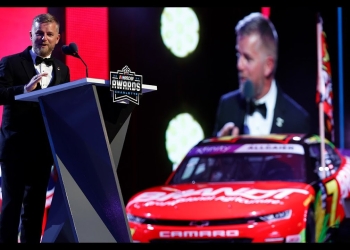The Abrupt End to Ryan Blaney's Watkins Glen Aspirations: A Deep Dive into NASCAR's Damaged Vehicle Policy
In the high-octane world of NASCAR, where fortunes can change faster than a pit crew can change tires, Ryan Blaney's early exit from the Watkins Glen race left fans and pundits alike scratching their heads. The incident serves as a stark reminder of the razor-thin margins between triumph and tribulation in this pedal-to-the-metal sport.
Let's cut to the chase: Blaney's day at The Glen was over before it really began, thanks to NASCAR's controversial damaged vehicle policy. But before we dive into the nitty-gritty, let's set the scene.
The Glen: Where Rubber Meets Road... and Sometimes Wall
Watkins Glen International, nestled in the picturesque Finger Lakes region of New York, is a track that separates the wheat from the chaff. It's a road course that demands precision, guts, and a dash of madness. Drivers don't just race here; they dance on the edge of disaster with every turn.
"Watkins Glen isn't just a race; it's a high-speed chess match played at 180 mph," as one seasoned crew chief once quipped.
And in this chess match, Blaney found himself in check before he could even make his opening move.
The Incident: When Seconds Feel Like Eternity
Picture this: The green flag drops, engines roar to life, and 40 cars hurtle towards the first turn like a stampede of mechanical beasts. In the midst of this controlled chaos, Blaney's car suffers damage. It's not a spectacular crash that sends parts flying like confetti at a victory lane celebration. No, it's more insidious than that.
The damage? Seemingly minor. The consequence? RACE-ENDING.
In the blink of an eye, Blaney's hopes of conquering The Glen vanished faster than a case of cold ones at a tailgate party. But why? The answer lies in the labyrinthine rulebook of NASCAR, specifically the damaged vehicle policy.
The Policy: A Double-Edged Sword
NASCAR's damaged vehicle policy is about as popular as a rain delay on race day. It's a rule that can make grown men weep and crew chiefs unleash profanities that would make a sailor blush. The policy states:
- Teams have a 7-minute window to repair damage on pit road
- If repairs can't be completed in time, it's sayonara, baby
- Once a car is taken to the garage, it's game over
Click here to preview your posts with PRO themes ››
Now, you might be thinking, "Seven minutes? That's longer than it takes to microwave a TV dinner!" But in the world of NASCAR, where milliseconds can mean the difference between glory and obscurity, seven minutes is a lifetime... and sometimes, it's not nearly enough.
The Ticking Clock: A Race Against Time
Imagine the scene: Blaney's crew, a well-oiled machine under normal circumstances, suddenly thrust into a high-stakes game of "Beat the Clock." Tools flying, sparks showering, and the relentless tick-tock of the countdown echoing in their ears.
It's enough to make your palms sweat just thinking about it, isn't it?
But here's the kicker: Sometimes, the damage isn't immediately apparent. It's like trying to diagnose a complex medical condition in the time it takes to boil an egg. And in Blaney's case, the prognosis came too late.
The Aftermath: Frustration, Debate, and a Touch of Controversy
As Blaney's car was wheeled away, a collective groan echoed through the NASCAR fandom. Social media exploded faster than a nitro-fueled dragster, with fans and critics alike weighing in:
"Is the damaged vehicle policy too harsh?" "Should there be exceptions?" "Is this what NASCAR wants – less cars on track?"
The debate rages on, fiercer than a rivalry between two drivers vying for the championship. Some argue the policy promotes safety and prevents rolling chicanes from clogging up the track. Others claim it's robbing fans of seeing their favorite drivers battle back from adversity.
But here's the rub: In the world of NASCAR, rules are rules. They're not just guidelines, suggestions, or friendly recommendations. They're ironclad laws, enforced with the unwavering resolve of a traffic cop who's just spotted you doing 90 in a school zone.
The Bigger Picture: A Sport in Evolution
Blaney's early exit from Watkins Glen isn't just a standalone incident; it's a microcosm of the larger changes sweeping through NASCAR. The sport is evolving, sometimes faster than a restrictor plate can limit horsepower.
Click here to preview your posts with PRO themes ››
From stage racing to playoff points, from composite bodies to the Next Gen car, NASCAR is a far cry from the good ol' days when moonshiners turned racers ruled the roost. It's a brave new world, and incidents like Blaney's serve as stark reminders of how the landscape has shifted.
Looking Ahead: What's Next for Blaney and NASCAR?
As the dust settles on this Watkins Glen debacle, questions linger like the smell of burnt rubber on a hot track:
- Will this incident spark a review of the damaged vehicle policy?
- How will Blaney bounce back in the next race?
- Could this early exit impact his playoff chances?
Only time will tell. But one thing's for certain: In NASCAR, as in life, the only constant is change. And if you can't stand the heat... well, you know the rest.
As we look to the horizon, one can't help but wonder what other curveballs NASCAR has in store. Will we see drones replacing spotters? Hybrid engines roaring alongside V8s? Or perhaps holographic drivers for those too chicken to face The Big One at Talladega?
Whatever the future holds, one thing remains certain: NASCAR will continue to push the boundaries, challenge the status quo, and occasionally ruffle a few feathers along the way. And we, the fans, will be there for every heart-pounding, jaw-dropping moment.
So buckle up, race fans. The ride's far from over. And who knows? The next turn could be the most exciting yet.









